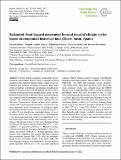Por favor, use este identificador para citar o enlazar a este item:
http://hdl.handle.net/10261/258065COMPARTIR / EXPORTAR:
 SHARE SHARE
 CORE
BASE CORE
BASE
|
|
| Visualizar otros formatos: MARC | Dublin Core | RDF | ORE | MODS | METS | DIDL | DATACITE | |

| Título: | Enhanced flood hazard assessment beyond decadal climate cycles based on centennial historical data (Duero basin, Spain) |
Autor: | Benito, Gerardo CSIC ORCID ; Castillo, Olegario; Ballesteros-Cánovas, Juan Antonio CSIC ORCID ; Machado, María J. CSIC ORCID; Barriendos, Mariano | Fecha de publicación: | 2-dic-2021 | Editor: | European Geosciences Union | Citación: | Hydrology and Earth System Sciences 25: 6107–6132 (2021) | Resumen: | Current climate modelling frameworks present significant uncertainties when it comes to quantifying flood quantiles in the context of climate change, calling for new information and strategies in hazard assessments. Here, state-of-the-art methods on hydraulic and statistical modelling are applied to historical and contemporaneous flood records to evaluate flood hazards beyond natural climate cycles. A comprehensive flood record of the Duero River in Zamora (Spain) was compiled from documentary sources, early water-level readings and continuous gauge records spanning the last 500 years. Documentary evidence of flood events includes minute books (municipal and ecclesiastic), narrative descriptions, epigraphic marks, newspapers and technical reports. We identified 69 flood events over the period 1250 to 1871, of which 15 were classified as catastrophic floods, 16 as extraordinary floods and 38 as ordinary floods. Subsequently, a two-dimensional hydraulic model was implemented to relate flood stages (flood marks and inundated areas) to discharges. The historical flood records show the largest floods over the last 500 years occurred in 1860 (3450 m3 s−1), 1597 (3200 m3 s−1) and 1739 (2700 m3 s−1). Moreover, at least 24 floods exceeded the perception threshold of 1900 m3 s−1 during the period (1500–1871). Annual maximum flood records were completed with gauged water-level readings (pre-instrumental dataset, PRE: 1872–1919) and systematic gauge records (systematic dataset, SYS: 1920–2018). The flood frequency analyses were based on (1) the expected moments algorithm (EMA) and (2) the maximum likelihood estimator (MLE) method, using five datasets with different temporal frameworks (historic dataset, HISTO: 1511–2018; PRE–SYS: 1872–2018; full systematic record, ALLSYS: 1920–2018; SYS1: 1920–1969; and SYS2: 1970–2018). The most consistent results were obtained using the HISTO dataset, even for high quantiles (0.001 % annual exceedance probability, AEP). PRE–SYS was robust for the 1 % AEP flood with increasing uncertainty in the 0.2 % AEP or 500-year flood, and ALLSYS results were uncertain in the 1 % and 0.2 % AEP floods. Since the 1970s, the frequency of extraordinary floods (>1900 m3 s−1) declined, although floods on the range of the historical perception threshold occurred in 2001 (2075 m3 s−1) and 2013 (1654 m3 s−1). Even if the future remains uncertain, this bottom-up approach addresses flood hazards under climate variability, providing real and certain flood discharges. Our results can provide a guide on low-regret adaptation decisions and improve public perception of extreme flooding. | Versión del editor: | https://hess.copernicus.org/articles/25/6107/2021/hess-25-6107-2021-discussion.html | URI: | http://hdl.handle.net/10261/258065 | DOI: | 10.5194/hess-25-6107-2021 | ISSN: | 1027-5606 |
| Aparece en las colecciones: | (MNCN) Artículos |
Ficheros en este ítem:
| Fichero | Descripción | Tamaño | Formato | |
|---|---|---|---|---|
| Benito_G_Enhanced_flood.pdf | Artículo principal | 34,96 MB | Adobe PDF |  Visualizar/Abrir |
CORE Recommender
SCOPUSTM
Citations
14
checked on 30-mar-2024
WEB OF SCIENCETM
Citations
12
checked on 21-feb-2024
Page view(s)
41
checked on 22-abr-2024
Download(s)
33
checked on 22-abr-2024
Google ScholarTM
Check
Altmetric
Altmetric
Este item está licenciado bajo una Licencia Creative Commons

